
| WWT Shows | CLICK TO: Join and Support Internet Horology Club 185™ | IHC185™ Forums |

|
• Check Out Our... • • TWO Book Offer! • |
Welcome Aboard IHC185™  Internet Horology Club 185
Internet Horology Club 185  IHC185™ Discussion Site Main Page
IHC185™ Discussion Site Main Page  Technical, Shop Talk and Internet Links
Technical, Shop Talk and Internet Links  Clock Repair Questions and Answers
Clock Repair Questions and Answers  Care & Maintenance of older Marine Chronometers
Care & Maintenance of older Marine Chronometers
 Internet Horology Club 185
Internet Horology Club 185  IHC185™ Discussion Site Main Page
IHC185™ Discussion Site Main Page  Technical, Shop Talk and Internet Links
Technical, Shop Talk and Internet Links  Clock Repair Questions and Answers
Clock Repair Questions and Answers  Care & Maintenance of older Marine Chronometers
Care & Maintenance of older Marine ChronometersGo  | New Topic  | Find-Or-Search  | Notify  | Tools  | Reply to Post  |  |
I recently saw a George Blackie chronometer offered for sale that appears to be original and in good working order. 1) Is it ok to run these older chronometer or should they just be shelf items. 2) Do you set the time by physically moving the hands or is there another method used? 3) The internet Bio on George Blackie is rather scarce. This chronometer is number marked on the dial, the tub, and box). Does anyone have any estimate on when various numbers might have been made & any ideas on finding out their history, which could be interesting? | |||
|
| IHC Member 1335 |
Quoting from: Tony Mercer, Chronometer Makers of the World (Colchester, 1991), p. 109. _________________________________ As you can see from this #892 was apparently made in the early 1870s. The chronometer looks right as rain , and is lovely ,wish it were mine Box Chronometer Catalogue number: ME*314261 Inscriptions: "GEOE. BLACKIE, (/) 24 AMWELL STREET LONDON. (/) PRIZE MEDALS 1862 & 1857 (/) 892" and "U.S. ARMY" Dimensions: bezel 4.9 inches diameter; backplate 3.1 inches diameter Discussion: This is a 56 hour chronometer that was probably made in the early 1870s. It has a later pattern Earnshaw spring detent escapement, and indications for hours, minutes, seconds, and up and down. George Blackie was a reputable chronometer maker who won first prize in the Greewich Trials of 1858. The U.S. Navy Bureau of Ships transferred this instrument to the Smithsonian in 1953. ___________________________________ | |||
|
| IHC Life Member Site Moderator |
Very Nice! In Loomes 21st century ed. it lists George Blackie London born 1813 died 1885. He & his wife Ellen Brown were married April 18, 1849 in Islington, Middlesex. In the 1861 census he is listed as living at 44 Amwell St., born about 1814 in Scotland, he is listed as a Chronometer maker. He is married to Ellen (born about 1828), son George (born about 1850), daughter Ellen E. (born about 1853), son Francis J. (born about 1859), son Percy B. (born about 1861). His wife & children were all born in Middlesex. In 1881 he is listed as living at 46 Highbury Hill, he is listed as a watchmaker finisher. Living with him are daughter Ellen, son Francis J., daughter Jessie F.(born 1865) son Arthur (born about 1869) In the England Wales Death Index he is listed as born about 1813 & died July 1885 in Islington, Greater London, London, Middlesex. This image is from the England & Wales National Probate Calendar  | |||
|
| IHC Life Member Site Moderator |
1848 London Post Office Directory  | |||
|
| IHC Life Member Site Moderator |
Mason Hope you don't mind all this, I am trying to see if I can locate any mention of your chronometer but I thought I would post what I find along the way. This is from "A catalogue chronologically arranged of the collection of clocks, watches ... By Henry Leonard Nelthropp" 1902 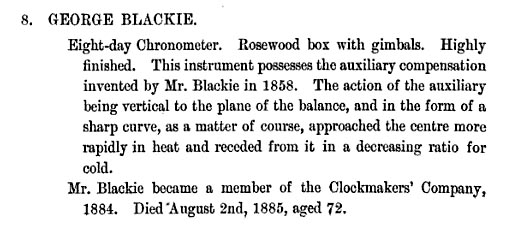 | |||
|
| IHC Life Member Site Moderator |
I thought this was interesting. From "A treatise on watch-work, past and present By Henry Leonard Nelthropp" 1873 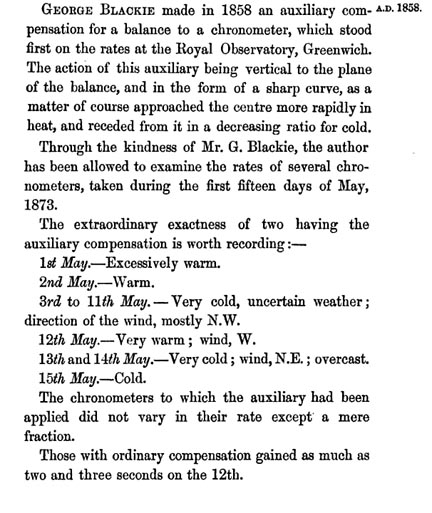 | |||
|
| IHC Life Member Site Moderator |
I don't know if this would help date your chronometer but number 789 on the dial mentions his award of 1862. I wonder if that would mean yours is earlier than 1862? 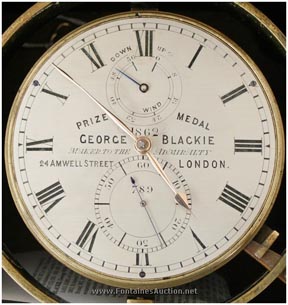 | |||
|
Thanks for the information! Interestingly, George Blackie is also mentioned in an April 1873 "All The Year Round" article by Charles Dickens where he references the Nelthrope treatise. And in an 1884 volume of "English Mechanic and World of Science" there is also a mention of a Blackie chronometer with a "new auxiliary compenstion (description unpublished)" winning a "compensation balance" competition in 1858. Lastly, I have been in brief contact with the "Worshipful Clockmaker's Company" guild in London and verified that he was admitted as a membmer in 1884. After having it examied by a professional and allowing it to acclimate to our South Georgia humid climate for a few days, I wound it and it started right up and has been keeping really good time (with daily windings) ever since. Thanks again for the great info! | ||||
|
I am a real armature beginner when it comes to examining the technology of the details of a chronometer. Is it possible to tell by looking at my chronometer whether or not it has the auxiliary compensation balance invented by Blackie in 1858? I am trying to narrow down the date of mfg. If my #721 has the auxiliary compensation device, then I can assume it is post 1858; if not, it is possibly older. Are there any other clues I might look for? Thanks in advance, Mason 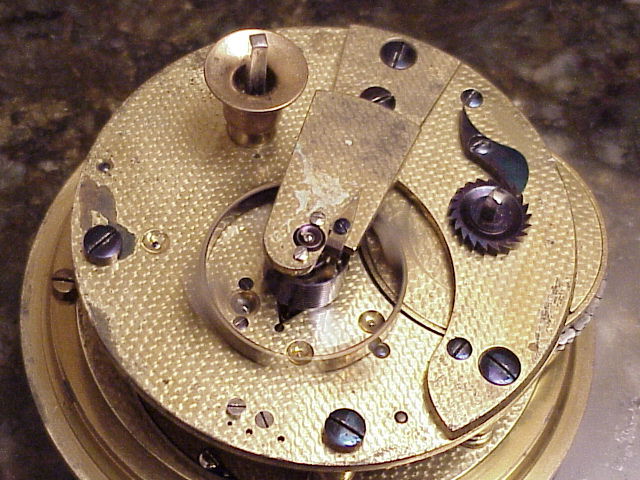 | ||||
|
| IHC Life Member Site Moderator |
Mason I think we would need a photo of the balance & hairspring at rest to determine what it might be. Tom | |||
|
Attached are several photos of the internals of the Blackie chronometer. According to the only descripiton I have seen of the Auxilliary compensation invented by Blackie that won him the 1858 Greenwich prize is that:"The action being vettical to the plane of the baance, and in the form of a sharp curve, as a mater of course, approached the center more rapidly in heat and receded form it in a decreasing fashion for cold" Do the attahced photos give any clues as to the this chronometer's approx mfg date as it may relate to the 1858 auxilliary compensation addtition or any other mechanism visible. Any ideas or suggestions appreciated. Thanks in advance, Mason 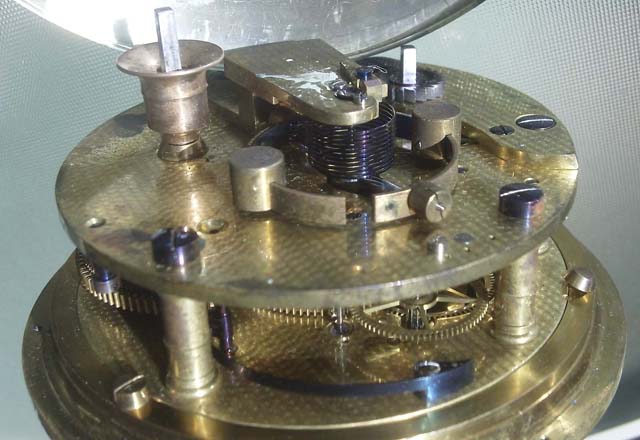 | ||||
|
| Powered by Social Strata |
| Your request is being processed... |
|
Welcome Aboard IHC185™  Internet Horology Club 185
Internet Horology Club 185  IHC185™ Discussion Site Main Page
IHC185™ Discussion Site Main Page  Technical, Shop Talk and Internet Links
Technical, Shop Talk and Internet Links  Clock Repair Questions and Answers
Clock Repair Questions and Answers  Care & Maintenance of older Marine Chronometers
Care & Maintenance of older Marine Chronometers
 Internet Horology Club 185
Internet Horology Club 185  IHC185™ Discussion Site Main Page
IHC185™ Discussion Site Main Page  Technical, Shop Talk and Internet Links
Technical, Shop Talk and Internet Links  Clock Repair Questions and Answers
Clock Repair Questions and Answers  Care & Maintenance of older Marine Chronometers
Care & Maintenance of older Marine Chronometers©2002-2025 Internet Horology Club 185™ - Lindell V. Riddle President - All Rights Reserved Worldwide

